A 15-year-old boy with infected food
A 15-year-old boy is admitted to the hospital for evaluation and treatment of an infected right foot. The history of the chief complaint began when the patient was playing with another boy on a trampoline four days earlier. While jumping together, his friend came down and his foot landed on the patient’s right foot. There was immediate pain, but no break in the skin was noted as a result of the accident. However, he did have a summer-long history of itching with resultant rubbing between his toes prior to the event. He noted increasing pain and was seen 48 hours later by his primary care physician. His PCP diagnosed him with early cellulitis, and prescribed Keflex (cephalexin), a first-generation cephalosporin, at 500 mg three times per day. The next day, he noted some bloody drainage from between his second and third toes with swelling such that he could not put on his shoe, and was then admitted to the hospital. He also complained of some nausea without vomiting the night before, which was possibly related to the medication.
He is otherwise healthy with no significant past medical or surgical history. His immunizations are up to date. A review of systems reveals only mild developmental delay, recurrent otitis media when he was much younger and the history noted above of apparent intertriginous tinea pedis.

Pediatric Infectious Disease, Scott and White's Children's Health Center and Associate Professor of Pediatrics,
Texas A&M University, College of Medicine, Temple, Texas.
e-mail: jhbrien@aol.com
Examination revealed a healthy-appearing 15-year-old boy with normal vital signs. The only positive finding was a painful, swollen right foot, with overlying erythema involving the second toe and extending onto the dorsum of the foot as shown in figures 1-2. There was also some spontaneous bloody discharge with chunks of what appeared to be thick, yellowish exudate mixed in (figures 3-5, views from the plantar surface).
Lab tests included a Gram stain, fungal stain with bacterial and fungal cultures of the discharge is pending. A complete blood count was normal with a blood culture also pending. Plain radiographs of the foot are shown in figures 6-7.
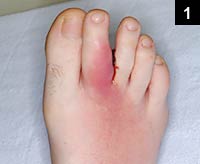
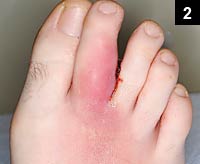
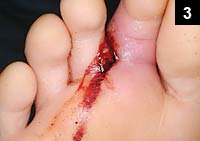
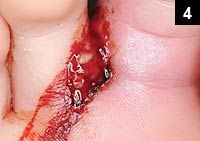
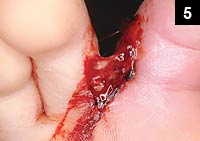
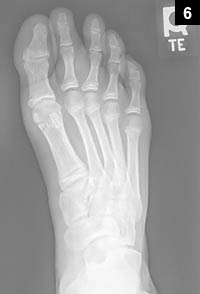
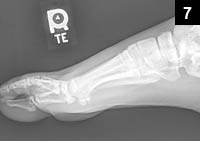
What’s Your Diagnosis?
- Pseudomonas aeruginosa osteochondritis
- Staphylococcus aureus cellulitis with abscess
- Trichophyton mentagrophytes cellulitis with abscess
- Streptococcus pyogenes cellulitis with abscess
Answer
The most likely answer is B, Staphylococcus aureus cellulitis with abscess formation, and indeed, that is what grew from the culture of the exudate. In fact, anytime S. aureus is in the list of choices regarding cellulitis with abscess formation, it is always the most likely answer. However, the foot can be heavily colonized with Gram-negative rods as well, including Pseudomonas aeruginosa. Because this may be playing some role in the process, the empiric antibiotics used pending culture results in this case were clindamycin and gentamicin. A podiatry consult was obtained after the pictures were taken, and the abscess was further drained and packed. With preliminary identification of the organism, and dramatic clinical improvement, he was discharged the next day on oral clindamycin. The staph turned out to be methicillin-sensitive, which demonstrated the shortcoming of otherwise effective antibiotics (Keflex) when an abscess is involved. Conversely, we have seen time and again the resolution of Staphylococcal soft tissue infections with drainage alone, as shown in figure 8, a patient sent home on Keflex after drainage, before finding out that the staph was methicillin-resistant. When she was recalled a few days later, the infection had resolved, despite being on the wrong antibiotic.
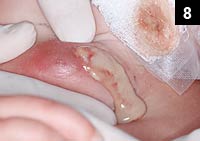
The presence of tinea pedis, with its macerating effect on the skin between the toes no doubt set the stage for the secondary invasion of the staph. These dermatophyte infections of the feet are very common among adolescent boys. The characteristic peeling of the skin between the toes can be seen between the other toes on the plantar views in figures 3-4. All it needed was some otherwise minor injury to the area to result in a crack in the skin to provide a port of entry for the staph. By coincidence, we had another adolescent male admitted with the same problem a month earlier. Their histories were essentially the same, differing only in the mechanism of the injury (figures 9–11). This boy simply “stubbed” his second toe while playing football barefooted at a nearby lake. Although one might be tempted to think of more exotic bacteria, being that it happened at a lake, it turned out to be also due to S. aureus, only this one was methicillin-resistant.
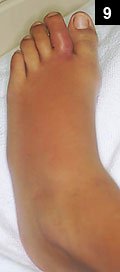
Trichophyton mentagrophytes as well as T. rubrum and other less common dermatophytes are the most common causes for tinea pedis and can damage the skin, but in the normal host are not capable of resulting in an infection like these shown here. Many experts believe that these dermatophytes may require the presence of a low-grade bacterial infection, along with moisture to be able to invade the skin (Lawrence Eichenfield in chapter 268, page 1,253 in the 2nd edition of Principles and Practice of Pediatric Infectious Diseases, by Long, Pickering and Prober). When diagnosed, these foot fungi are usually treated with topical imidazoles, along with keeping the infected skin dry.
Group A strep (Streptococcus pyogenes) can certainly cause cellulitis with pus production, as implied by its name. Although it may be found on the foot, it is not a common organism there. When it is seen, infections due to group A strep are usually rapid in progression, whereas S. aureus infections are a bit slower to develop.
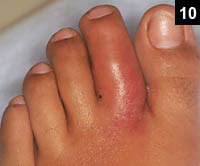
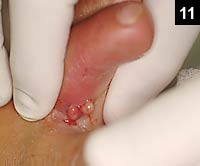
Lastly, P. aeruginosa is a common foot organism, especially in those wearing sneakers, but in immunocompetent people, it needs a little help, such as a puncture wound to the foot, to establish a soft tissue or bone and/or cartilage infection. When this occurs, the signs and symptoms of the infection are usually present about a week or more after the puncture wound occurred. The plain radiographs are often normal, as was the case in the patient presented, except for the soft tissue swelling (figures 6-7). When Pseudomonas osteochondritis is suspected, we will now use MRI as a much better means of confirming the diagnosis as shown in figure 12, a child with osteochondritis due to a nail puncture of the 5th metatarsal.
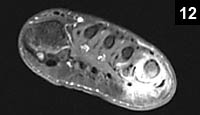
Commentary
Do I really need to say anything about trampolines? If you are reading this, you are probably a pediatrician, and you probably know firsthand the risks of unsupervised, backyard trampoline use. It is just one of the many summertime hazards children face. When I was 50 pounds lighter and 40 years younger, I was fairly skilled on the trampoline. However, all of my experience was in my college gym with spotters and, in the beginning, a safety harness. This is not exactly the same thing as a parent setting up a backyard trampoline and telling their 12-year-old to go have a good time. History has recorded many trampoline-related injuries, some minor, some tragically severe. In my opinion, these devices are no more appropriate for unsupervised, backyard use than an unsupervised backyard swimming pool with toddlers around. Enough said.
Don’t forget to get your influenza immunization. You can’t help your patients if you are sick, plus you may inadvertently spread it to some of your unimmunized high-risk patients. You should be starting your patients at high-risk for respiratory syncytial virus (RSV) on their Synagis prophylaxis by now as well.
Lastly, I had the golden opportunity in September to be the visiting professor for a week at the Kapiolani Women and Children’s Hospital at the University of Hawaii in Honolulu. In addition to being in a tropical paradise, I had the privilege of speaking with some of the brightest residents and staff I have ever encountered. Raul Rudoy, an internationally recognized pediatric infectious disease specialist, heads the department of pediatrics. The director of the infectious diseases section, however, is Marian Melish, one of the world’s leading experts on staphylococcal disease and Kawasaki Disease.
Before leaving on my last day, I had the rare opportunity of seeing a baby with Incomplete Kawasaki Disease in the emergency room with Dr. Melish. This is sort of like discussing a case of polio with Jonas Salk, as Dr. Melish is the American pioneer of Kawasaki Disease. In fact, she independently reported the syndrome in Pediatric Research in the same year that Tomisaku Kawasaki published the first English-language report in Pediatrics. Ten minutes with Dr. Melish probably doubled my knowledge of Incomplete Kawasaki Disease.
While in Hawaii, I also gave the morning conference for the department of pediatrics at Tripler Army Medical Center. It is noteworthy that the chief of pediatrics as well as the chief of radiology were both deployed to Iraq. Sometimes rank has privileges and sometimes it doesn’t. Sometimes it carries responsibilities, and leading by example is one of them.
What’s Your Diagnosis? is a monthly case study featured in Infectious Diseases in Children, with treatment information and discussion to follow.
